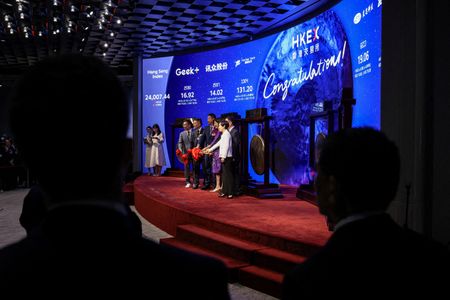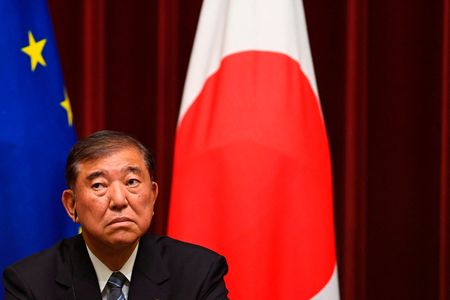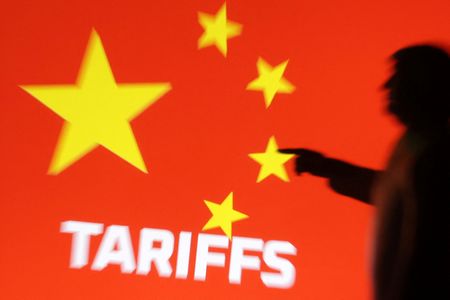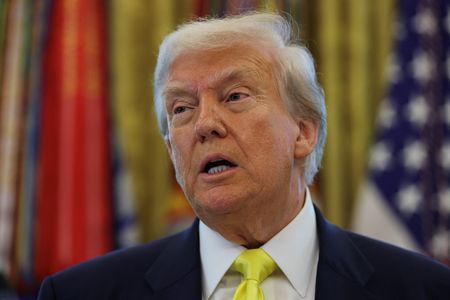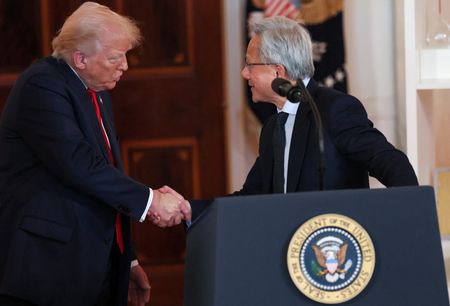By Trevor Hunnicutt and Andrea Shalal
WASHINGTON (Reuters) -U.S. President Donald Trump extended a tariff truce with China by another 90 days on Monday, a White House official said, staving off triple-digit duties on Chinese goods as U.S. retailers prepared for the critical end-of-year holiday season.
Trump signed an executive order delaying the start of higher tariffs until mid-November shortly after giving reporters a noncommittal answer when asked at a news conference if he planned to keep the lower tariff rates in place. On Sunday, Trump demanded China quadruple its purchases of U.S. soybeans, but it remained unclear whether Beijing had agreed.
The tariff truce between Beijing and Washington had been due to expire on Tuesday at 00:01 ET (04:01 GMT). The timing of the extension until early November buys crucial time for the seasonal autumn surge of imports for the Christmas season, including electronics, apparel and toys at lower tariff rates.
The new order prevents U.S. tariffs on Chinese goods from shooting up to 145%, while Chinese tariffs on U.S. goods were set to hit 125% – rates that would have resulted in a virtual trade embargo between the two countries. It locks in place – at least for now – a 30% tariff on Chinese imports, with Chinese duties on U.S. imports at 10%.
“We’ll see what happens,” Trump told a news conference earlier on Monday, highlighting what he called his good relationship with Chinese President Xi Jinping.
“It’s positive news. Combined with some of the de-escalatory steps both the United States and China have taken in recent weeks, it demonstrated that both sides are trying to see if they can reach some kind of a deal that would lay the groundwork for a Xi-Trump meeting this fall,” said Wendy Cutler, a former senior U.S. trade official who is now a vice president at the Asia Society Policy Institute.
Trump told CNBC last week that the U.S. and China were getting very close to a trade agreement and he would meet with Xi before the end of the year if a deal was struck.
TRADE ‘DETENTE’ CONTINUED
The two sides in May announced a truce in their trade dispute after talks in Geneva, Switzerland, agreeing to a 90-day period to allow further talks. They met again in Stockholm, Sweden, in late July, and U.S. negotiators returned to Washington with a recommendation that Trump extend the deadline.
Treasury Secretary Scott Bessent has said repeatedly that the triple-digit import duties both sides slapped on each other’s goods in the spring were untenable and had essentially imposed a trade embargo between the world’s two largest economies.
“It wouldn’t be a Trump-style negotiation if it didn’t go right down to the wire,” said Kelly Ann Shaw, a senior White House trade official during Trump’s first term and now with law firm Akin Gump Strauss Hauer & Feld.
She said Trump had likely pressed China for further concessions before agreeing to the extension. Trump pushed for additional concessions on Sunday, urging China to quadruple its soybean purchases, although analysts questioned the feasibility of any such deal. Trump did not repeat the demand on Monday.
“The whole reason for the 90-day pause in the first place was to lay the groundwork for broader negotiations and there’s been a lot of noise about everything from soybeans to export controls to excess capacity over the weekend,” Shaw said.
Ryan Majerus, a former U.S. trade official now with the King & Spalding law firm, said the news would give both sides more time to work through longstanding trade concerns.
“This will undoubtedly lower anxiety on both sides as talks continue, and as the U.S. and China work toward a framework deal in the fall,” he said.
Imports from China early this year had surged to beat Trump’s tariffs, but dropped steeply in June, Commerce Department data showed last week. The U.S. trade deficit with China tumbled by roughly a third in June to $9.5 billion, its narrowest since February 2004. Over five consecutive months of declines, the U.S. trade gap with China has narrowed by $22.2 billion – a 70% reduction from a year earlier.
No formal announcement was immediately released. The Treasury Department and U.S. Trade Representative’s Office did not respond to requests for comment.
Washington has also been pressing Beijing to stop buying Russian oil, with Trump threatening to impose secondary tariffs on China.
(Reporting by Trevor Hunniccutt and Andrea Shalal; Editing by Bernadette Baum, Rod Nickel and Nia Williams)








